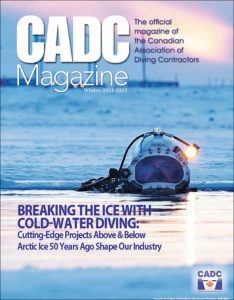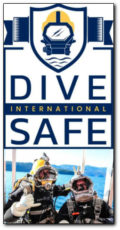CADC MAG DIGITAL VERSION AVAILABLE – WINTER 2021-22: 50 Years BENEATH THE ICE
By CADC Admin ~ January 26th, 2022. Filed under: CADC MAG.
 As we transition from Winter 2021 over to Winter 2022, it seems from all reports from members that it’s been a busy year for our underwater industry in Canada and the U.S.
As we transition from Winter 2021 over to Winter 2022, it seems from all reports from members that it’s been a busy year for our underwater industry in Canada and the U.S.
Our cover is all about that season called winter, which we, in the northern hemisphere, experience every year at this time. It has a lot to do with ice. I remember my first ice dive in the boonies of Northern Ontario on Lake Superior. Wearing an ill-fitting wetsuit, we figured it’d be fun to go out, chip a hole in the ice, and see what was under there! At the time, it was around -20°C. The spot we picked was near a rocky shore among broken ice. We quickly found out the extreme cold over the last month had created three feet of ice to chop through.
After a few hours, we ended up with a four-foot-diameter funnel hole—four feet at the top and less than three feet at the bottom. The only way in was feet-first, holding your arms at your side and having someone step on your head to pop you through the bottom of the ice hole. We didn’t really think about the exit or have a plan if something went wrong. Visions of travelling through the birth canal flooded my thoughts as the foot on my head pushed me down, and I considered this might not be a good idea. Nevertheless, I popped out of the hole and stared through an icy face mask.
Blurry vision. Lips freezing. Cold water down my back. And the most amazing sight I’d ever seen, as light from the surface reflected through the broken ice chunks near the shore. It was like being in Superman’s Fortress of Ice. Amazing. Unforgettable. Little did I know then, this dive was the beginning of a career in commercial dive operations in, on, and under Canadian ice-covered waters.
Our cover story offers a look at 50 years above and below the ice in Canada. The story chronicles several significant pioneering expeditions in underwater living experiments and deep diving in the early 1970s; some under six feet of ice in the high Arctic! I was fortunate enough to be a part of that team as we demonstrated a capability to operate under Canadian ice-covered waters. Much of the cold-water technology we have today was inspired by those early days. What was that journey like? What was it like to LIVE under the ice? Follow the journey on page 16, where we highlight a bit of history in the development of commercial diving in Canada.
Being a busy year for contractors, a common concern from our members is the lack of qualified occupational divers to meet their requirements. This is a problem across the entire country, and not only in Canada but in the U.S., too. The reason for this shortage is discussed on page 25 in Do We Need More Occupational Divers? by David Parkes of the Diver Certification Board of Canada.
Discussions of personnel shortages over the year sparked a need for a serious upgrade to the UnderwaterJOBS.com website that Canadian Association of Diving Contractors (CADC) has supported. (Full disclosure: I, Doug Elsey, have been the webmaster of this site since its beginning.) The site has been completely updated and is compatible with mobile smartphones. It looks simple, but don’t let that fool you. If you need a diver with DCBC / CSA dive certification, who knows how to weld and lives in Nova Scotia (or anywhere else in the world!) and is available, the UnderwaterJOBS.com site will find that person in seconds, all from a smartphone! Read about the changes on page 10 and sign up for it! It’s free to register for jobseekers and employers.
In 2017, the CADC introduced the Diving Safety Self-Audit Program to provide a way for CADC members to demonstrate they’re working in a safe manner and complying with the CSA Diving Standards. On page 29, we update readers on the CADC’s new diving safety self-audit based on the new Diving Operations Standard Z275.2-20.
Four women in Ontario Power Generation’s Advanced Inspection and Maintenance division broke new ground as they set out on one of the company’s first-ever, all-female dives this summer. The crew geared up to conduct maintenance work on Pickering Nuclear’s Fish Diversion System, a 2,000-foot net that prevents fish from entering the plant’s cooling systems. Learn more on page 22 by reading OPG’s Female Divers Take the Plunge to Break Barriers.
On page 32, Our Members at Work photo spread shows images of an industry, from members’ diving jobs.
One of the most underrated parts of a health and safety plan is communication. You can have all the policies, procedures, and protocols in the world—but if you don’t communicate them properly to your dive team, you have nothing. As you’ll learn on page 33 in ToolBox Talk: The Importance of Having a Daily One, the most beneficial way of communicating the safety plan is through toolbox talks. They lead to an opportunity for discussion, giving employees the ability to recognize and control the hazards in their workplace and allowing dive crew members to ask questions, request clarification, and add their own input.
It’s your industry. Be heard. Be safe.
DOWNLOAD PDF VERSION: CADC Mag WINTER 2021-22 FINAL SMALL
VIEW THE ONLINE VERSION OF THE MAGAZINE HERE: CADC Magazine | Winter 2021-2022 (matrixgroupinc.net)







